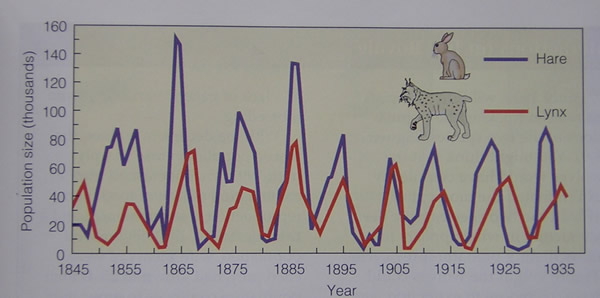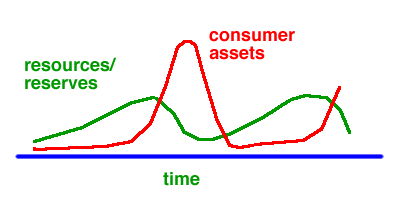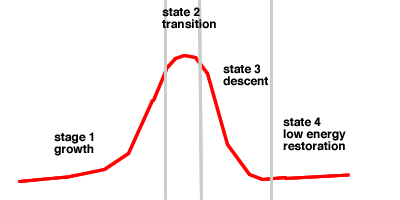grazing a pasture intensely and then letting it recover
fish eat the high density patches of algae
tundra - the productivity rate is as high as in tropical forests
predatory prey cycles

objects/succession-pulsing.html
A good reference is:
Odum, Howard T. and Elisabeth C. Odum. 2001.A Prosperous Way Down: Principles
and Policies. University Press of Colorado. Chapter 5.
grazing a pasture intensely and then letting it recover
fish eat the high density patches of algae
tundra - the productivity rate is as high as in tropical forests
predatory prey cycles
resources are used by consumers to create assets
|
 |
four states (as described by Odum and Odum 2001) low energy transition is the restructuring of resources into a usable (exploitable) form |
 |
models with only several components and very simple rules may show pulsing behavior
this means that this process doesn't require complicated interactions or explicit time lags
if it can happen in simple systems, it must be considered a possible behavior of more complicated systems
complexity
- simple systems can show complex behavior
- due to interactions of components under some conditions
- the parameters are not causal (can't say factor X will lead to pulsing)
- the system is the "cause", the interactions
- difficult to "prove" that there will be pulsing in any particular set of conditions
- but, what if pulsing were extremely important for the success of your management plan?
response to the criticism of "circular logic"
- From Bateson 2002 pg 18
- "How is the world of logic, which eschews "circular argument," related to a world in which circular trains of causation are the rule rather than the exception?"
pulsing at small scales can contribute to function of next larger scale
- pulsing populations of mice and wolves help structure ecosystem
pulses at larger scale may force many smaller systems to reset
fires, floods, etc. across a larger landscape
A similar view to pulsing is presented by Gunderson and Hollings (2002) in "Panarchy".
multiple scales - pan(across)-hierarchy
resilience cycle at each scale
Why do systems pulse?
What is the mechanism that causes this behavior?
How can you tell if a system you are watching is going to pulse?
see SLAFE.html